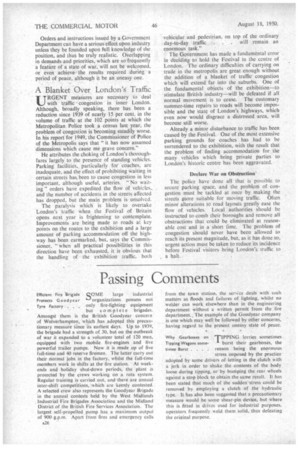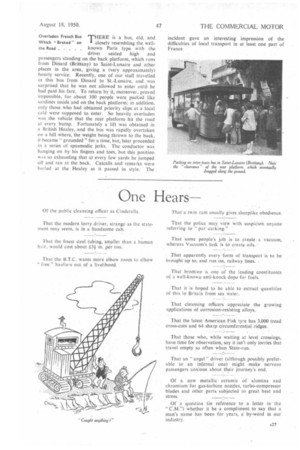Passing Comments
Page 28

Page 29

If you've noticed an error in this article please click here to report it so we can fix it.
S0 E large industrial
Efficient Fire 'Brigade Protects Goodyear Tyre Factory .
organizations possess not only -fire-fighting equipment but complete brigades. Amongst them is the British Goodyear concern of Wolverhampton, which has adopted this precautionary measure since its earliest days. Up to 1939, the brigade had a strength of 30, but on the outbreak of war it expanded to a volunteer total of 120 men, equipped with two mobile fire-engines and five powerful trailer pumps. Now it is made up of five full-time and 40 reserve firemen. The latter carry out their normal jobs in the factory, whilst the full-time members work in shifts at the tire station. At weekends and holiday shut-down periods, the plant is protected by the crews working on a rota system. Regular training is carried Out, and there are annual inter-shift competitions, w hich are keenly contested. A selected crew also represents the Goodyear Brigade in the annual contests held by the West Midlands Industrial Fire Brigades Association and the Midland District of the British Fire Services Association. The largest self-propelled pump has a maximum output of 900 g.p.m. Apart from fires and emergency calls from the town station, the serk,,:ce deals with such matters as floods and failures of lighting, whilst no welder can work elsewhere than in the engineering department without a written permit from the tire department._ The example of the Goodyear company is one which may well be followed by other concerns, having regard to the present uneasy state of peace.
Why Gearboxes on TIPPING lorries sometimes Tipping Wagons someA burst their gearboxes, the times Burst . . . . reason being the enormous stress imposed by the practice adopted by some drivers of letting in the clutch with a jerk in order to shake the contents of the body loose during tipping, or by bumping the rear wheels against a stop block to obtain the same result. It has been stated that much of the sudden stress could be removed by employing a clutch of the hydraulic type. It has also been suggested that a precautionary measure would be some shear-pin device, but *here this is fitted in drives used for industrial purposes, operators frequently weld them solid, thus defeating the original purpose.
Overladen French Bus THERE is a bus, Old, and Which "Braked" on A closely resembling the well the Road known Paris type with the driver seated high and passengers standing on the back platform, which runs from Dinard (Brittany) to Saint-Lunaire and other places in the area, giving a (very approximately) hourly service. Recently, one of our stall travelled in this bus from Dinard to St.-Lunaire, and was surprised that he was not allowed to enter until he had paid his fare. To return by it, moreover, proved impossible, for about 100 people were packed like sardines inside and on the back platform; in addition, only those who had obtained priority slips at a local caf6 were supposed to enter. So heavily overladen was the vehicle that the rear platform hit the road at every bump. Fortunately a lift was obtained in a British Healey, and the bus was rapidly overtaken on a hill where, the weight being thrown to the back, it became " grounded" for a time, but, later proceeded in a series of spasmodic jerks. The conductor was hanging on by his fingers and toes, but this position was so exhausting that at every few yards he jumped off and ran at the back. Catcalls and remarks were hurled at the Healey as it passed in style. The incident gave an interesting impression of the difficulties of local transport in at least one part of France












































































